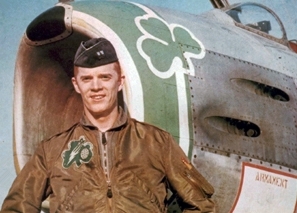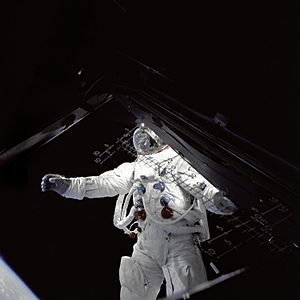Rusty Schweickart facts for kids
Quick facts for kids
Rusty Schweickart
|
|
|---|---|

Schweickart in 1971
|
|
| Born |
Russell Louis Schweickart
October 25, 1935 Neptune, New Jersey, U.S.
|
| Awards | NASA Distinguished Service Medal |
| Space career | |
| NASA astronaut | |
| Rank | Captain, USAF |
|
Time in space
|
10d 1h 0m |
| Selection | NASA Group 3 (1963) |
|
Total EVAs
|
1 |
|
Total EVA time
|
1h 17m |
| Missions | Apollo 9 |
|
Mission insignia
|
|
| Retirement | 1977 |
Russell Louis "Rusty" Schweickart, born on October 25, 1935, is an American engineer and a former NASA astronaut. He also worked as a research scientist, a U.S. Air Force fighter pilot, and a business and government leader.
In 1963, NASA chose Schweickart to be part of its third group of astronauts. He served as the Lunar Module Pilot on the Apollo 9 mission in 1969. This was the first time the lunar module was tested with a crew in space. During this mission, he performed the first test of the portable life support system. This system was vital for astronauts who later walked on the Moon.
Later, in 1973, he was a backup commander for the first crewed Skylab mission. He helped create the tools and plans that allowed the first crew to fix the Skylab space station while it was in orbit. After his time with Skylab, he worked at NASA helping to share its technology with others.
Schweickart left NASA in 1977. He then worked for California Governor Jerry Brown, focusing on science and technology. He was also appointed to California's Energy Commission, where he served for over five years and was chairman for three.
In the mid-1980s, Schweickart helped start the Association of Space Explorers. This group is for people who have flown in space. In 2002, he also co-founded the B612 Foundation. This non-profit group works to protect Earth from asteroid impacts. He served as its chairman for a time and is now its chairman emeritus.
Contents
Early Life and Education
Rusty Schweickart was born on October 25, 1935, in Neptune Township, New Jersey. He grew up on a farm where his family grew hay and vegetables and raised animals. When he was young, he dreamed of becoming a pilot and a cowboy.
After finishing high school in 1952, he went to the Massachusetts Institute of Technology (MIT) on a scholarship. He earned a bachelor's degree in aeronautical engineering in 1956. Later, in 1963, he received a master's degree in aeronautics and astronautics from MIT.
He was active in the Boy Scouts of America and reached the rank of First Class Scout. His hobbies include golf, bicycling, and hiking. He is married and has children.
Military and NASA Career

Schweickart served in the U.S. Air Force and the Massachusetts Air National Guard from 1956 to 1963. He flew for over 4,000 hours, with 3,500 hours in fast jet aircraft.
Before joining NASA, Schweickart was a research scientist at MIT. He studied the upper atmosphere, how to track stars, and how to keep stellar images steady. His master's degree research focused on light from the stratosphere.
In October 1963, NASA selected Schweickart as part of its third group of astronauts. He was the youngest in this group. He was named as a backup pilot for the Apollo 1 mission in 1966. This mission was supposed to be the first crewed Apollo flight, but it was destroyed during a ground test.
In December 1966, Schweickart and his crewmates were chosen to fly the first crewed test of the Apollo Lunar Module (LM) in Earth orbit. Schweickart was the Lunar Module Pilot for this mission.
Spaceflight Experience
The Apollo 9 mission took place in March 1969. Schweickart spent just over 10 days in space. During this mission, he performed the first spacewalk (called an extravehicular activity or EVA) of the Apollo program. He tested the portable life support system that would be used by astronauts walking on the Moon.
The original plan was for him to practice moving from the lunar module to the command module using handrails. However, he felt sick from space adaptation syndrome on the first day. This caused the spacewalk to be delayed.
Eventually, he felt better and performed a short spacewalk. His feet were held in place on the LM's "porch," which was a platform used for transferring to the ladder. Meanwhile, Command Module Pilot David Scott performed a stand-up spacewalk from the command module's open hatch. During a five-minute break outside his spacecraft, Schweickart looked at Earth. He felt a deep connection to the universe. After this experience, he began practicing Transcendental Meditation.
Skylab and Beyond
After his Apollo 9 mission, Schweickart chose not to be assigned to another flight right away. He wanted to learn more about space sickness. He spent six months as a "motion sickness guinea pig" to help researchers understand how astronauts react to space.
This testing period meant he wasn't assigned to the backup crew for Apollo 12. Instead, he moved to the Skylab program. He was assigned as a backup commander for Skylab 2, the first crewed American space station mission, which flew in 1973.
When the space station lost its heat shield during launch, Schweickart took charge. He helped develop the tools and plans to put up an emergency sunshade and fix a stuck solar panel. These actions were crucial and saved the space station.
After working on Skylab, Schweickart became interested in management. He was reassigned to NASA Headquarters in Washington, D.C., in 1974. He became the Director of User Affairs in the Office of Applications. In this role, he helped share NASA's technology, like information from the Landsat 1 satellite, with people outside NASA. He worked with groups like the U.S. Department of Agriculture to understand their needs and connect them with NASA's work. He found this job challenging because people were often hesitant to adopt new technologies. This, along with fewer immediate flight opportunities, led him to leave NASA in 1977.
Post-NASA Career

After leaving NASA, Schweickart worked for two years as an assistant for science and technology to California Governor Jerry Brown. Then, Governor Brown appointed him to the California Energy Commission, where he served for five and a half years.
Inspired by his friendships and involvement in exchange programs, Schweickart helped create the Association of Space Explorers (ASE) in 1984–85. He founded it with cosmonauts Alexei Leonov, Vitaly Sevastyanov, and Georgi Grechko. This organization is open to all people who have flown in orbit around Earth. He also led the ASE's committee on near-Earth objects. This committee wrote an important report about asteroid threats and presented it to the United Nations Committee on the Peaceful Uses of Outer Space.
Schweickart retired from ALOHA Networks, Inc. in 1998. He had served as President and Chief Executive Officer there from 1996 to 1998. ALOHA was a company that made wireless internet access equipment.
Before that, Schweickart was an Executive Vice President at CTA Commercial Systems, Inc. He also led efforts to develop the GEMnet system, which was a satellite network for global electronic messaging. He also founded Courier Satellite Services, Inc., a company that developed satellites for affordable data services worldwide.
His work with satellites and telecommunications involved him in creating international communication rules. He participated in the 1992 and 1995 World Radiocommunication Conferences. He also worked a lot in Russia on science and telecommunications.
In 2002, he co-founded the B612 Foundation with fellow former-astronaut Ed Lu and two planetary scientists. The B612 Foundation is a non-profit group focused on protecting Earth from asteroid impacts. He also served as its Chair.
In May 2005, Schweickart spoke to the U.S. Congress about the dangers of an asteroid impact, specifically mentioning 99942 Apophis. In 2010, he co-chaired a task force on Planetary Defense for the NASA Advisory Council. He has supported increasing NASA's budget to find more near-Earth objects that could threaten Earth and to develop ways to deflect them.
Schweickart has also spoken and taught at the Esalen Institute. He currently serves as the B612 Foundation's Chair Emeritus.
Awards and Honors
For his Apollo 9 flight, he received the NASA Distinguished Service Medal in 1969. He also received the Fédération Aéronautique Internationale De la Vaulx Medal in 1970. In 1969, he earned a Special Trustees Award (Emmy Award) for sending the first live TV pictures from space.
In 1973, Schweickart was given the NASA Exceptional Service Medal for his important role in the Skylab rescue efforts. He was inducted into the International Space Hall of Fame in 1983. In 1997, he was inducted into the U.S. Astronaut Hall of Fame. An asteroid, 17033 Rusty, was named in his honor.
In 2012, Schweickart was inducted into the International Air & Space Hall of Fame at the San Diego Air & Space Museum.
His grandfather moved from Lembach, a small town in Alsace, France, to the United States in 1892. After visiting Lembach several times, Schweickart was made an honorary citizen of the town.
Portrayals
In the 1998 HBO miniseries From the Earth to the Moon, Rusty Schweickart was played by Kieran Mulroney. He also appeared in the television series The Universe in episodes about space threats and stopping potential disasters.
See also
 In Spanish: Russell Schweickart para niños
In Spanish: Russell Schweickart para niños
- B612 Foundation
- Spaceguard
- The Astronaut Monument



